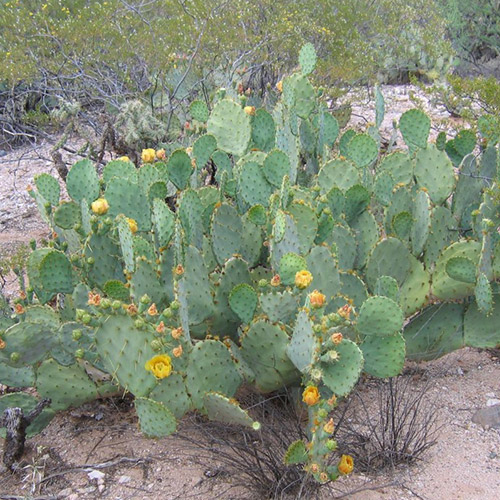📷 Joe Shaw, wikimedia.org
Opuntia engelmannii var lindheimeri aka Texas Prickly 🍐Pear
Opuntia | Updated: February 15, 2025
This highly recognizable cactus has broad, flat pads covered in sharp pines. It is evergreen, and can grow tall. The pads are blue-green, and grow from a trunk. As it grows, it can spread out. Watch for yellow flowers that bear a purple fruit in the Spring.
Quick Guide
- Full sun to partial shade 🌤️
- Typical water needs for a succulent
- Plant grows up to 5′ (1.5 m) tall
- Plant grows up to 8′ (2.4 m) wide
- Zone 8a (Minimum 10° F | -12° C)
- Not cold hardy
- Propagation by stem cuttings and seeds
- Generally non-toxic to people and pets
- Winter Dormant
How to 🩷 Care for and Propagate Your 🪴 Succulents
General Care for Opuntia engelmannii var lindheimeri aka Texas Pricklypear
Opuntia engelmannii var lindheimeri aka Texas Pricklypear is an excellent addition to outdoor succulent gardens. It is deer-resistant and provides nectar for bees and hummingbirds with its flowers.
Watering
Texas Pricklypear has typical succulent watering needs. Use the soak and dry method, allowing the soil to dry out completely between waterings.
Where to Plant
This variety is not cold hardy, so if you live in a zone colder than 10°F (-12°C), plant it in a container that can be brought indoors. It thrives in full to partial sun.
Plant in an area that receives at least 6 hours of sunlight daily. For indoor overwintering, place near a southern-facing window in the Northern Hemisphere. Supplement with a grow light as needed.
How to Propagate Opuntia engelmannii var lindheimeri aka Texas Pricklypear
Propagation of Texas Pricklypear can be done through stem cuttings or seeds.
Cuttings
Take stem cuttings using a sterile, sharp knife or scissors. Let the cut end callous for several days before planting in well-draining soil. Water only when the soil is completely dry.
Seeds
Harvest seeds from mature fruit of the plant. Allow the fruit to over-ripen, then remove and clean the seeds. Dry them before planting in well-draining soil.
Tags & Attributes
Scientific Classification
Kingdom: Plantae
Clade: Tracheophytes
Clade: Angiosperms
Clade: Eudicots
Order: Caryophyllales
Family: Cactaceae
Genus: Opuntia
Species: O. lindheimeri



